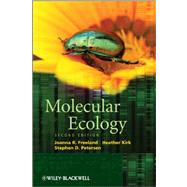
Note: Supplemental materials are not guaranteed with Rental or Used book purchases.
Purchase Benefits
Looking to rent a book? Rent Molecular Ecology [ISBN: 9780470748336] for the semester, quarter, and short term or search our site for other textbooks by Freeland, Joanna R.; Petersen, Stephen D.; Kirk, Heather. Renting a textbook can save you up to 90% from the cost of buying.
Acknowledgements.
1 Molecular Genetics in Ecology.
What is molecular ecology?
The emergence of molecular ecology.
Protein allozymes.
Allozymes as genetic markers.
An unlimited source of data.
Mutation and recombination.
Is genetic variation adaptive?
Polymerase chain reaction.
Getting data from PCR.
Real-time PCR.
Overview.
Chapter summary.
Useful websites and software.
Further reading.
Review questions.
2 Molecular Markers in Ecology.
Understanding molecular markers.
Modes of Inheritance.
Nuclear versus organelle.
Haploid chromosomes.
Identifying hybrids.
Uniparental markers: A cautionary note
Molecular markers.
Co-dominant markers.
Dominant markers.
Overview.
Chapter summary.
Useful websites and software.
Further Reading.
Review questions.
3 Genetic Analysis of Single Populations.
Why Study Single Populations?
What is a population?
Quantifying genetic diversity.
Hardy-Weinberg equilibrium.
Estimates of genetic diversity.
Haploid diversity.
Choice of marker.
What Influences Genetic Diversity?
Genetic drift.
What is effective population size?
Quantifying census population size.
Quantifying effective population size.
Demographic influences on Ne.
Ne, genetic drift and genetic diversity.
Population bottlenecks.
Founder effects and invasive species.
Natural selection.
The major histocompatibility complex.
Reproduction.
Overview.
Chapter summary.
Useful websites and software.
Further reading.
Review questions.
4 Genetic Analysis of Multiple Populations.
Why study multiple populations?
Quantifying Population Subdivision.
Genetic distance.
F-statistics.
Interpreting FST.
Non-a priori identification of populations.
Quantifying Gene Flow.
Direct methods.
Indirect methods.
Assignment tests.
What Influences Gene Flow?
Barriers to dispersal.
Landscape genetics.
Metapopulations.
Interspecific interactions.
Hybridization.
Population differentiation: genetic drift and natural selection.
Gene flow and genetic drift.
Gene flow and local adaptation.
Overview.
Chapter summary.
Useful websites and software.
Further reading.
Review questions.
5 Studying Ecologically Important Traits: Ecogenomics, QTL Analysis, and Reverse Genetics.
Studying ecologically important traits.
cDNA libraries and ESTs.
Microarrays.
How do microarrays work?
Probes.
Verifying differences in gene expression.
Microarray applications.
Microarrays and community ecology of microorganisms.
Microarrays and genotyping.
Connecting genotype to phenotype.
Reverse genetics.
QTL analysis.
Linkage mapping.
QTL mapping.
QTL mapping of ecologically important traits.
Overview.
Chapter Summary.
Useful Websites and Software.
Further Reading.
Review Questions.
6 Phylogeography.
What is Phylogeography?
Molecular markers in phylogeography.
Organelle versus nuclear markers.
Repetitive versus non-repetitive markers.
Molecular clocks.
Bifurcating trees.
The coalescent.
Applying the coalescent.
Networks.
NCPA and statistical phylogeography.
The distributions of genetic lineages.
Subdivided populations.
Dispersal and vicariance.
Comparative phylogeography.
Regional concordance.
Continental concordance.
European post-glacial recolonization routes.
Dispersal and invasive species.
Allele sharing between species.
Lineage sorting.
Hybridization.
Overview.
Chapter summary.
Useful websites and software.
Further reading.
Review questions.
7 Behavioural Ecology.
Why use molecules to study behaviour?
Mating systems.
Parentage analysis.
Extra-pair fertilizations.
Social breeding.
Social insects.
Manipulating sex ratios.
Sex ratio conflicts.
Sex-biased dispersal.
Nuclear and mitochondrial markers.
Relatedness.
FST values.
Assignment tests.
Spatial autocorrelation.
Concordant results.
Predators and prey.
Identifying prey.
Predation and conservation.
Overview.
Chapter summary.
Useful websites and software.
Further reading.
Review questions.
8 Conservation Genetics.
The need for conservation.
Taxonomy.
Species concepts.
DNA barcoding.
Subspecies.
Conservation units.
Hybrids.
Population size, genetic diversity and inbreeding.
Inbreeding depression.
Heterozygosity fitness correlations.
Self-fertilization.
Inbreeding avoidance
Outbreeding depression.
Translocations.
Genetic rescue.
Source populations.
Restoration genetics.
Captive breeding.
Maximizing genetic diversity.
Captive inbreeding and outbreeding.
Genetic diversity banks.
Overview.
Chapter summary.
Useful websites and software.
Further Reading.
Review questions.
Glossary.
Answers to Review Questions.
References.
Index.
The New copy of this book will include any supplemental materials advertised. Please check the title of the book to determine if it should include any access cards, study guides, lab manuals, CDs, etc.
The Used, Rental and eBook copies of this book are not guaranteed to include any supplemental materials. Typically, only the book itself is included. This is true even if the title states it includes any access cards, study guides, lab manuals, CDs, etc.